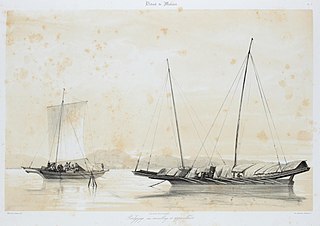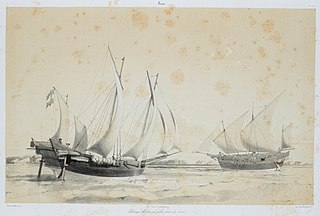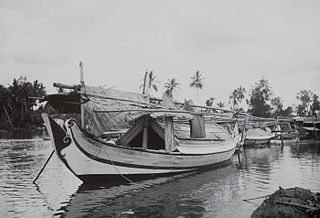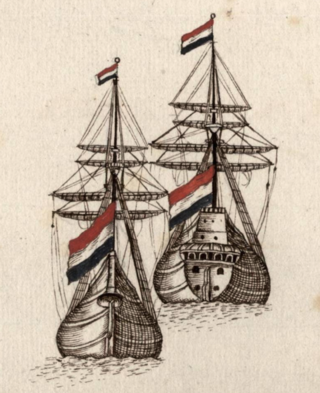
Steven van der Hagen was the first admiral of the Dutch East India Company (VOC). He made three visits to the East Indies, spending six years in all there. He was appointed to the Raad van Indië. Van der Hagen protested against the harsh administration of the administrators, who wanted a monopoly on the clove trade and were willing to fight against their Spanish, Portuguese, English or Asiatic trade competitors in order to get it. Laurens Reael and Steven van der Hagen wrote with disapproval on how the Heren XVII treated the interests and laws of the Maluku population.

Literally, the word pinisi refers to a type of rigging of Indonesian sailing vessels. A pinisi carries seven to eight sails on two masts, arranged like a gaff-ketch with what is called 'standing gaffs' — i.e., unlike most Western ships using such a rig, the two main sails are not opened by raising the spars they are attached to, but the sails are 'pulled out' like curtains along the gaffs which are fixed at around the centre of the masts.

Tongkang or "Tong'kang" refers to several type of boats used to carry goods along rivers and shoreline in Maritime Southeast Asia. One of the earliest record of tongkang has a background of 14th century, being mentioned in Malay Annals which was composed no earlier than 17th century. One passage mentioned it as being used by Majapahit empire during the 1350 attack on Singapura.

The term lambo or lamba refer to two types of traditional boats from Indonesia.

The pinas, sometimes called "pinis" as well, is a type of schooner of the east coast of the Malay peninsula, built in the Terengganu area. This kind of vessel was built of Chengal wood by the Malays since the 19th century and roamed the South China Sea and adjacent oceans as one of the two types of traditional sailing vessels the late Malay maritime culture has developed: The bedar and the pinas.

Penjajap, also pangajava and pangayaw, were native galley-like warships used by several Austronesian ethnic groups in maritime Southeast Asia. They were typically very long and narrow, and were very fast. They are mentioned as being used by native fleets in Indonesia, the southern Philippines, Malaysia, and Brunei.

The djong, jong, or jung is a type of sailing ship originating from Peninsula, Malaysia, Sumatera & Java, Indonesia that was widely used by Javanese, Sundanese, and later, also by Peguan, Malay, and East Asian sailors. The word was and is spelled jong in its languages of origin, the "djong" spelling being the colonial Dutch romanization. In English, the djong lends its name to other ships of similar configuration, called junks, and to their characteristic style of rigging, the junk rig.

Padewakangs were traditional boats used by the Bugis, Mandar, and Makassar people of South Sulawesi. Padewakangs were used for long-distance voyages serving the south Sulawesi kingdoms.

Pencalang is a traditional merchant ship from Nusantara. Historically it was also written as pantchiallang or pantjalang. It was originally built by Malay people from the area of Riau and the Malay Peninsula, but has been copied by Javanese shipwrights. By the end of the 17th century this ship has been built by Javanese and Chinese shipbuilders in and around Rembang. However it was a popular choice for Balinese skippers followed by Sulawesian skippers.

Perahu Mayang or simply mayang is a type of fishing boat from Java, Indonesia. This type of boat is used mainly for fishing and trading. Historically, this indigenous vessel is also favored by European skippers and private merchants for trading in East Indies: 50% of them were using mayang and pencalang. It is mostly used in northern coast of Java. The major production site is in Rembang, Central Java.

Toop is a type of boat-ship produced in East Indies. Appeared at the end of the 18th century, and built in local shipyards, this type of boat is one of the results of the incorporation of 'Western' and 'Nusantaran' technologies that began in the shipyards of the 17th and 18th European trading companies. This type of boat is commonly used for long-distance shipping. In the first half of the 19th century, this was the most common type of boat used by sailors and traders in Nusantara. Majority of toop is owned by merchants from the western area of Nusantara.

Golekan is a type of traditional boat from Madura, Indonesia. They once plied as far as Singapore, where they are referred to as Madurese traders. In the present this type of boat is only known locally, especially near Bangkalan in Western Madura and around the Kangean islands.

Leti leti is a type of traditional transport vessel from East Madura, Indonesia, especially from the administrative district of Sumenep. The leti leti is a recent development, the hull form and sail were developed in the 19th century. In 1979, sailing leti leti numbered about 1,000, but the number reduced over the next decades as more modern, motorized vessel appeared.

Janggolan refers to two different type of perahu from Indonesia. One is from Madura, and the other from Bali. The Madurese janggolan is a type of indigenously constructed boat, meanwhile Balinese janggolan is an indigenous boat with western-styled hull construction.

Palari is a type of Indonesian sailing vessel from South Sulawesi. It was mainly used by the people of Ara and Lemo Lemo, for transporting goods and people. This vessel is rigged with pinisi rig, which often makes it better known as "Pinisi" instead of its name. In Singapore, palari is known as "Makassartrader".

Volharding Dock, was a floating dry dock built for the Nederlands Indische Droogdok Maatschappij (NIDM) in the 1870s. It was the smallest of two unique tower dry docks, and the only one that would actually be put in use.

The Ardjoeno class was a ship class of paddle-steamers of the Royal Netherlands Navy. The class comprised Ardjoeno, Gedeh (1850), Amsterdam and Gedeh (1874).

Heemskerck was the flagship of Abel Janszoon Tasman's exploratory voyage of 1642. She and her consort Zeehaen were the first European ships to explore the south coast of Australia, including Tasmania, cross the Tasman Sea, and reach New Zealand among other achievements.

The Old Company was a pre-company of the Dutch Republic and originated from the Company of Verre and the New Company, from Amsterdam, in 1598. The directors were Dirck van Os, Jan Hermansz, Jan Janss Carel (Kaerel) and Geraerdt (Gerrit) Bicker. Directors with a smaller share of the investment were: Vincent van Bronckhorst, Symon Jansz Fortuyn, Geurt Dircxz, Cornelis van Campen, Jacob Thomasz Van den Dael, Elbert Simonsz Jonckheyn, Petrus Plancius, Syvert Sern, Jan Poppe, Geurt Dirckss and Pieter Hasselaer. The Old Company and the (New) Brabant Company would merge in 1601 and become the United Amsterdam Company.

























